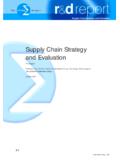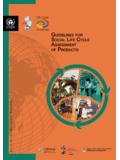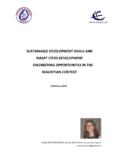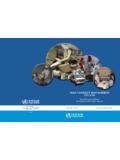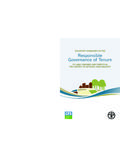Transcription of THE SIGMA GUIDELINES- TOOLKIT
1 THE SIGMA guidelines - TOOLKIT SIGMA OPPORTUNITY AND RISK GUIDE 1 SIGMA sustainable development OPPORTUNITY AND RISK GUIDE Contents 1. 2. What are sustainable development opportunities and risks?..4 Operational opportunities and External opportunities and Relationship opportunities and 3. How do I manage them?..5 Gain top-level Define your sustainable development risk strategy and Opportunity and risk identification and Agreeing and implementing an opportunity and risk management Monitoring opportunities and Communicating opportunity and risk 4. Key lessons and things to 5 Key 5 Things to 5. Links and Appendix 1 - Guidance for opportunity and risk Appendix 2 Examples of opportunity and risk management approaches and their main 2 ACKNOWLEDGMENTS We would like to thank the following for their expertise, enthusiasm and input to this guide: Emma Humphrey BAA Ian Blythe Andrew Jenkins Boots Anita Longley Penny Tomlinson Innogy Fran Leedham Jaguar & Land Rover Kathryn Jones Northumbrian Water Tom Dalziel Powergen Bob Allen-Turl TNT Cheryl Foreman Vauxhall Dave Knight Sd3 31.
2 Introduction The SIGMA sustainable development Opportunity and Risk Guide is intended to provide a basic overview and simple guidance and tools to enable organisations to improve their understanding and management of risks and opportunities relating to sustainable development . It is not intended to be a comprehensive guide to all elements of opportunity and risk management. It represents a collation of work and thinking from organisations involved in a pilot of the SIGMA guidelines and from the SIGMA project team. The content reflects the focus of activity from the pilot, which primarily covered identification and assessment of sustainable development , and in particular social and environmental, risks and opportunities. It is aimed at people with responsibility for sustainability management and also those with responsibility for risk management within organisations.
3 2. What are sustainable development opportunities and risks? sustainable development opportunities and risks are threats to the ongoing success of an organisation as a result of an environmental, social or economic issue1. This includes not fully realising opportunities that may contribute to this success. It concerns those risks and opportunities that are not adequately covered by existing management approaches. They can arise in three key areas: Operational opportunities and risks This relates to how an organisation impacts on the interests, values and actions of specific stakeholder groups and broader society through its operations. The potential risks and opportunities result from an organisation failing to achieve objectives that are dependent on stakeholder support and good will. Examples would be: where environmental damage occurs as a result of an operational failure such as a pipeline leak polluting a river; when labour conditions are poor such as use of sweatshop labour in the supply chain; or where an opportunity exists due to a gap in the market for an improved product or service such as a chance to develop a chemical leasing service rather than just supplying chemicals.
4 External opportunities and risks This relates to the impact of external factors in society upon an organisation s activity, the results of which may lead to constraints and limitations to an organisation s operations. Examples of these include; climate change limiting the ability to use traditional energy sources or working in conflict zones where business continuity and the safety of personnel may be at threat. Relationship opportunities and risks These risks are apparent when there are conflicting interests between an organisation and its stakeholders. Getting it right and optimising the relationship between the organisation and its stakeholders can provide many 4opportunities and minimise any threats. An example would be appropriately planning and locating new operations in a community. 3. How do I manage them? Figure 1 provides a process guide to managing opportunities and risks relating to sustainable development .
5 It should be noted that there are strong links between some aspects of risk assessment and many other management needs, such as procurement processes, health and safety assessments and sustainable marketing processes. Many organisations will already have risk management processes in place. It is normally preferable to enhance and integrate these processes rather than try to create a new layer of risk management. Indeed integrating sustainable development risks and opportunities into existing risk management processes will improve organisational understanding of wider uncertainties and opportunities relating to sustainable development issues. This, in turn, will support cultural change in an organisation. The process detailed below recommends key stages and considerations, rather than a definite model that has to be followed exactly. In many situations the process stages may not happen in this order, some may run concurrently and they may be amended to align to other existing activities.
6 The sustainable development opportunity and risk management process will now be explained on a step by step basis. Gain top-level commitment Top-level commitment to sustainable development opportunity and risk management is essential as it helps to raise the level of awareness of the risks and opportunities associated with sustainability issues. Top-level commitment is also required to ensure the ongoing effectiveness of the sustainable development opportunity and risk management process, including the allocation of an appropriate level of time and resources to the subject. For quoted companies, top-level commitment may relate to a Board desire to fully implement the combined code on corporate governance (Turnbull Report) in order to meet legal duties. For other organisations this commitment can also be driven by a need for more effective management.
7 There are close links to the development of a business case for sustainable development activities in organisations. 5 Figure 1. sustainable development opportunity and risk management process performance Stakeholder Engagement Gain top-level commitment /provide reassurance Communicate risk issues internally & externally Monitor & measure risk Agree risk management plan Complete risk identification & assessmentDefine/refine risk appetite & strategy Define your sustainable development risk strategy and appetite An existing organisational risk strategy may be extended to consider sustainable development opportunities and risks or, if appropriate, a separate opportunity and risk strategy covering sustainable development risks and opportunities should be defined. The opportunity and risk strategy should include: Risk appetite boundaries and approach Significance of, and priorities for, market opportunities identified Roles and responsibilities Timetables and milestones Resources and budgets Monitoring and review process Top-level management endorsement The risk appetite refers to how risk adverse an organisation is.
8 Factors that affect an organisation s risk appetite include: How far the organisation is committed to working to the SIGMA sustainability principles or to similar operating principles or codes of conduct 6 The organisations level of commitment to sustainable development issues, evidenced in operating principles, policies, strategies and adherence to guidelines and standards The degree to which opportunity and risk management activity supports the organisation s business plan, operations and core business processes and decision-making The risk hierarchy, shown in Figure 2, provides a guide to the priorities of managing sustainable development risks and opportunities and can help to define an organisation s risk appetite, response strategy and opportunity and risk management plan. The options represent choices on how to tackle sustainable development risks and opportunities with the top of the hierarchy being the most preferable and the bottom being the less preferable option.
9 There are other options to manage risk, which may be appropriate at any level of the hierarchy in addition to other risk management activity. These are: Accept the risk Transfer the risk Insure against the risk Roles and responsibilities There is a danger that opportunity and risk management remains the preserve of a small number of risk professionals in an organisation. A successful opportunity and risk process involves a broad spread of personnel representing all key business areas. This ensures that the range of risks and opportunities, are adequately captured, considered and managed in such a way as to minimise the negative and maximise the positive. 7 Most preferableapproach- ProactiveFigure 2. Risk management hierarchy Do NothingMitigate the risk impactsReduce the level of risk Avoid the riskTurn the risk into an opportunityLeast preferable approach - Reactive Expanding existing responsibilities or capturing existing information is more effective than creating a new layer to manage these wider risks and opportunities; or relying on a small number of experts to understand all business risks and opportunities.
10 Whatever approach is adopted should always include a clear definition of roles and responsibilities. Strategy review and refinement Opportunity and risk strategies may not need to be reviewed and refined as regularly as opportunity and risk assessments and monitoring programmes. However, timescales for review should be clearly stated and ideally be incorporated as part of the organisation s wider strategic review process. Opportunity and risk identification and assessment sustainable development opportunities and risks are those that are material not only to meeting the organisation s vision, mission, operating principles and objectives, but also those that are material to stakeholders and are therefore dependent on engaging with them. Appendix 1 - Guidance for opportunity and risk assessment can help organisations determine if a risk or opportunity is material or not.

